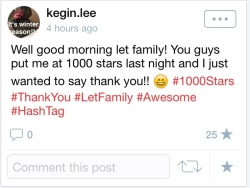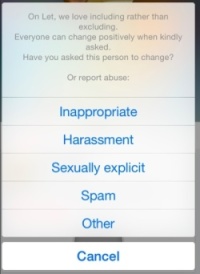 Last spring I asked, “Will safety ever be baked in to social apps?” Well, it’s actually starting to be. Let is a perfect example. A social app (mostly on Apple’s iOS phones) with an overwhelmingly teen-aged user base that launched last March, its L.A.- and Marseilles-based creators seem to have grown a digital community in which teens and young adults, mostly girls, feel safe and help each other thrive.
Last spring I asked, “Will safety ever be baked in to social apps?” Well, it’s actually starting to be. Let is a perfect example. A social app (mostly on Apple’s iOS phones) with an overwhelmingly teen-aged user base that launched last March, its L.A.- and Marseilles-based creators seem to have grown a digital community in which teens and young adults, mostly girls, feel safe and help each other thrive.
- Let users don’t just “like” each other’s photos, videos and comments (or in Let’s case, “star” them), they help each other grow their collections of stars – this app’s version of social media social capital. Not everybody, of course, but Let’s creators say this is one of the most common practices on the service, and I’ve experienced it in the app myself.
- Let prompts them to thank each other when they do that, showing them over and over how courtesy strengthens community and so promoting positive social norms.
- Let has “angels.” “One day [CEO] Pascal Lorne gathered in one chat room all the users who asked, ‘How can I help?'” writes my ConnectSafely.org co-director Larry Magid at SafeKids.com. Lorne “spent a lot of time with them teaching them nonviolent communication methods” and how to support fellow users and bring attention to interesting posts and kind actions. He told us he spends 2-3 hours a day in the community interacting with users and learning how they use the app.
- It’s prestigious to be an angel (see this page in Let’s Web site); other users aspire to having angel status, even though angels “don’t have any special powers per se,” a Let spokesperson said. “They do have the respect of the community, an open dialog with Let’s senior leadership, some training in non-violent communication and a deep love of the app and community. They also help get the word out about daily hashtags and activities on the app.”
What fuels all that, it appears, are intention and a whole lot of attention to what’s going on in the community. News coverage of Let has focused on the stars – both the social currency kind and the young social-media celebrities that have adopted Let to grow their fan bases. But the currency and the celebrity don’t seem to eclipse the community piece. A word Let staff use to describe what social media’s fans look for is “authenticity.” That could be seen as aspirational, but it is a key part of the appeal today’s young celebrities who get their start on YouTube and other social media have for their fans – they’re accessible, “real,” not divas and divos – which is why an app that invests a lot in maintaining a strong sense of community can be a useful base for both celebrities and fans.
As for the feature most often associated with community safety – abuse reporting – that too is done differently at Let. It’s not punitive. Users who are reported are encouraged to change their behavior; they’re not immediately timed out or banned. Even would-be reporters are asked to think before they report. As you can see from the screenshot of the abuse-reporting screen to the right, Let – along the lines of Facebook’s abuse-reporting options for teens – teaches a little social literacy right in the reporting process (note the question: “Everyone can change positively when kindly asked. Have you asked this person to change?”).
Toward a pro-social ecosystem (offline too)
Let also wants to grow use of pro-social media practices externally – by starting Kung Fu, a consortium for apps and other services that promote the positive in social media. It’s interested in hearing from all like-minded organizations, for profit or nonprofit.
No user-driven community can have perfect safety, I’m sure the people behind Let or any social media service would agree. I’m using Let as an example because it’s an indicator of where we’re going. A community-based approach to community wellbeing is only logical in a user-driven age. Punitive, top-down environments that try to control participants don’t ultimately work because we can’t both empower and disempower people at the same time. If we give them the tools of self-regulation and community improvement, such as digital and social literacy, we can’t represent them as potential victims and offenders and rely on tools of control. Safety, like citizenship, is only logically citizen-sourced. When it is, citizens realize they’re stakeholders in how things go. Social and other literacy training gives them the skills that increase their powers for good, whether or not they choose to use them. But most – like Let’s angels, I suspect – will exercise those powers.
Related links
- Some related posts of mine: “What does ‘safe’ really look like in a digital age?” (2012); “Why ‘anti-social media companies’ will be obsolete” (2011); “Social Web privacy: A new kind of social contract we’re all signed onto” (2010)
- “Balancing external with internal Internet safety ‘tools'”
- This 2010 post mentions findings in Harvard School of Education research that illustrates the impact of years of Internet safety messages portraying youth as potential victims online.
- This probably sounds like a bit much, but just for fun: When I heard about Let’s angels, I thought of the phrase “the better angels of our nature” and googled it. It was used by President Lincoln (see the last six words of his speech in Bartleby’s), who got it from either Charles Dickens (through one of his aides) or from reading Shakespeare’s Othello (which Lincoln apparently is known to have read). I do believe that communities can foster
- “Teen Social Network Let Raises $600K” in TechCrunch a couple of months ago
- “Teen social network Let moves to L.A. after winning over YouTube stars”
- Larry’s interview with Let CEO Pascal Lorne and Calvin Liu, the CEO of another app that has positivity baked in, Outpour…



I can see why this would be popular to our female teens. However, I would just like to ask, aren’t we just creating people who would eventually just become courteous or grateful because they are wanting flattery. Aren’t we just creating a need for a new currency (stars systems) where our teens must get their “fix” or they would implode randomly?
No question that’s possible, which is why digital media (not just digital and not just media) literacy is so important – the kind that gets our children thinking about these digital age versions of popularity contests (more on getting wise to gamification in social media and life here: http://nfn.wpengine.com/why-not-a-gazillion-likes-getting-wise-to-gamification-in-social-media-life). It really depends on how we treat and think about stars, likes, etc. It can just be fun to play the game – with a bit of awareness running in the background. Thanks for your question – sorry for the delayed response!